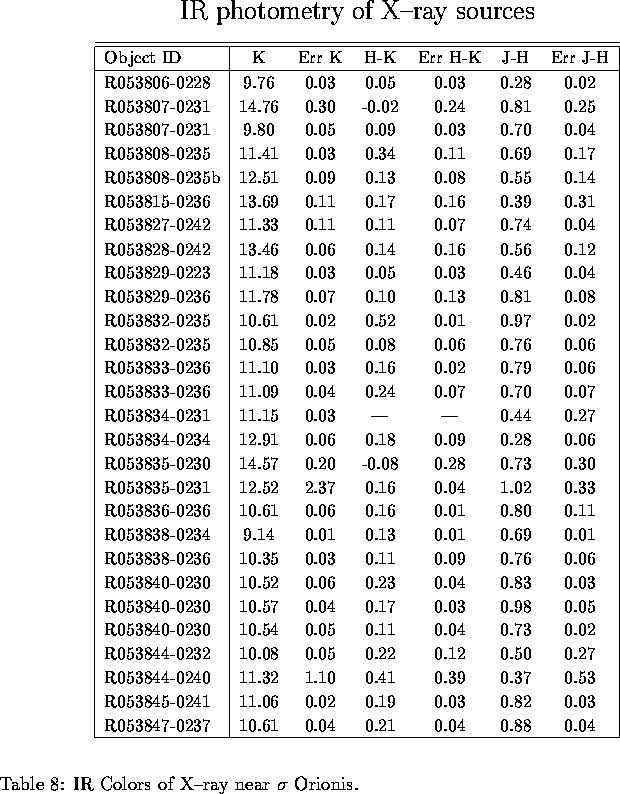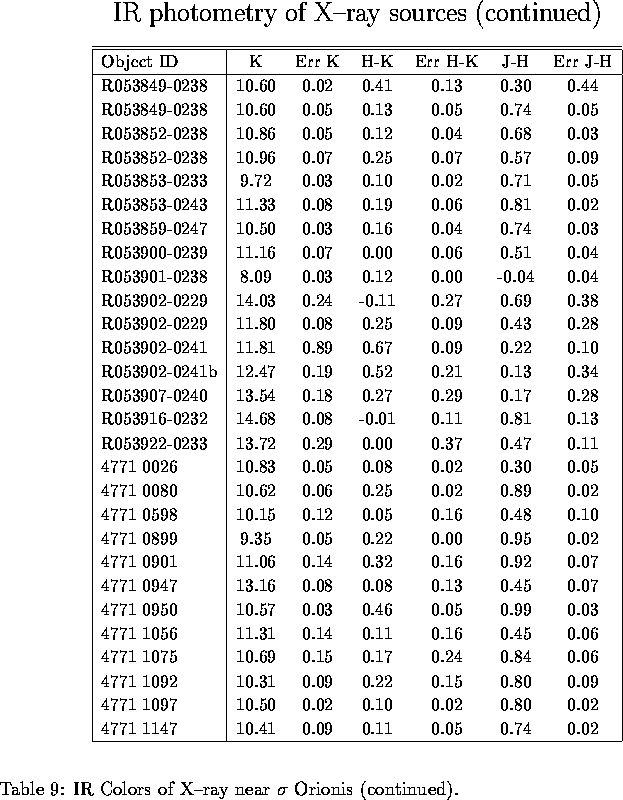


Next: Spectroscopic Data
Up: Calculation of Extinction
Previous: Calculation of Extinction
Near--infrared observations were made on 5--6 February 1996 at CTIO using the
CIRIM imager. CIRIM is a 256 256 HgCdTe array sensitive to near
infrared wavelengths. At the focus of the CTIO 1.5 meter, the pixels
are 1.16
256 HgCdTe array sensitive to near
infrared wavelengths. At the focus of the CTIO 1.5 meter, the pixels
are 1.16 on a side.
The field of view was about 5
on a side.
The field of view was about 5 , and J, H and K
filters were used. Sixteen fields near
, and J, H and K
filters were used. Sixteen fields near  Orionis were observed.
Exposure times averaged about 10 seconds in each filter with six coadds
per exposure. In the infrared, the sky background is high relative to
the dynamic range of the detector. This effect is mild at J--Band,
but it
limits K--band exposures to under 10 seconds. It is desirable to coadd several
exposures together. The nominal seeing at the CTIO 1.5 meter was about 0.8
arcseconds. Since the pixel size was larger than the nominal size of
a seeing disk, it was necessary to move the telescope several times
during the exposure sequence to get an accurate flux measurement. This
process is called dithering.
Five dithered exposures were taken of each field. As the first step in
the reduction, all frames had
a linearity correction applied (Elston 1994).
Afterward, the individual
frames were dark--subtracted and flatfielded. The dithered
frames, thus reduced, were then added together to create a composite
frame and median filtered to create a sky background frame.
This sky background frame was multiplied by five and then subtracted from the
composite frame to produce a final frame.
Orionis were observed.
Exposure times averaged about 10 seconds in each filter with six coadds
per exposure. In the infrared, the sky background is high relative to
the dynamic range of the detector. This effect is mild at J--Band,
but it
limits K--band exposures to under 10 seconds. It is desirable to coadd several
exposures together. The nominal seeing at the CTIO 1.5 meter was about 0.8
arcseconds. Since the pixel size was larger than the nominal size of
a seeing disk, it was necessary to move the telescope several times
during the exposure sequence to get an accurate flux measurement. This
process is called dithering.
Five dithered exposures were taken of each field. As the first step in
the reduction, all frames had
a linearity correction applied (Elston 1994).
Afterward, the individual
frames were dark--subtracted and flatfielded. The dithered
frames, thus reduced, were then added together to create a composite
frame and median filtered to create a sky background frame.
This sky background frame was multiplied by five and then subtracted from the
composite frame to produce a final frame.
Photometry was carried out only on those sources for which a possible
(not necessarily confirmed) optical counterpart to an X--ray source had been
identified. The IRAF/APPHOT package was used in a similar manner to the
optical data with a similar 4" radius aperture. In some cases, the dithering
procedure caused stars to overlap with other stars on
the final frame. In these cases, corrected single star frames were
measured using IRAF/APPHOT. Comparisons stars were taken from the
UKIRT faint standards (Casali & Hawarden 1992).
Standard stars were observed between five and nine times at
each airmass; airmasses ranged from 1.2 to 2.2. The solution for each
night was accurate to about 5% in each color. These analyses lead to
five measurements of each target star in each filter. The results
were averaged and are listed in Table 8.
The errors given
are the standard deviations among the five measurements.





Next: Spectroscopic Data
Up: Calculation of Extinction
Previous: Calculation of Extinction
Scott J. Wolk
Mon Dec 9 10:44:18 EST 1996
 256 HgCdTe array sensitive to near
infrared wavelengths. At the focus of the CTIO 1.5 meter, the pixels
are 1.16
256 HgCdTe array sensitive to near
infrared wavelengths. At the focus of the CTIO 1.5 meter, the pixels
are 1.16 on a side.
The field of view was about 5
on a side.
The field of view was about 5 , and J, H and K
filters were used. Sixteen fields near
, and J, H and K
filters were used. Sixteen fields near  Orionis were observed.
Exposure times averaged about 10 seconds in each filter with six coadds
per exposure. In the infrared, the sky background is high relative to
the dynamic range of the detector. This effect is mild at J--Band,
but it
limits K--band exposures to under 10 seconds. It is desirable to coadd several
exposures together. The nominal seeing at the CTIO 1.5 meter was about 0.8
arcseconds. Since the pixel size was larger than the nominal size of
a seeing disk, it was necessary to move the telescope several times
during the exposure sequence to get an accurate flux measurement. This
process is called dithering.
Five dithered exposures were taken of each field. As the first step in
the reduction, all frames had
a linearity correction applied (Elston 1994).
Afterward, the individual
frames were dark--subtracted and flatfielded. The dithered
frames, thus reduced, were then added together to create a composite
frame and median filtered to create a sky background frame.
This sky background frame was multiplied by five and then subtracted from the
composite frame to produce a final frame.
Orionis were observed.
Exposure times averaged about 10 seconds in each filter with six coadds
per exposure. In the infrared, the sky background is high relative to
the dynamic range of the detector. This effect is mild at J--Band,
but it
limits K--band exposures to under 10 seconds. It is desirable to coadd several
exposures together. The nominal seeing at the CTIO 1.5 meter was about 0.8
arcseconds. Since the pixel size was larger than the nominal size of
a seeing disk, it was necessary to move the telescope several times
during the exposure sequence to get an accurate flux measurement. This
process is called dithering.
Five dithered exposures were taken of each field. As the first step in
the reduction, all frames had
a linearity correction applied (Elston 1994).
Afterward, the individual
frames were dark--subtracted and flatfielded. The dithered
frames, thus reduced, were then added together to create a composite
frame and median filtered to create a sky background frame.
This sky background frame was multiplied by five and then subtracted from the
composite frame to produce a final frame.

